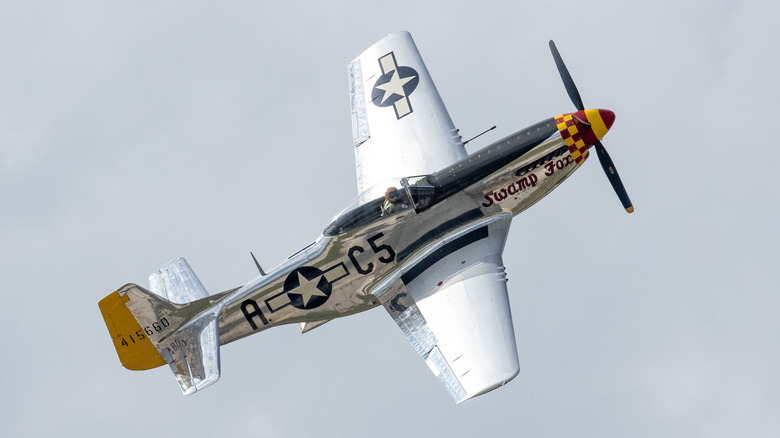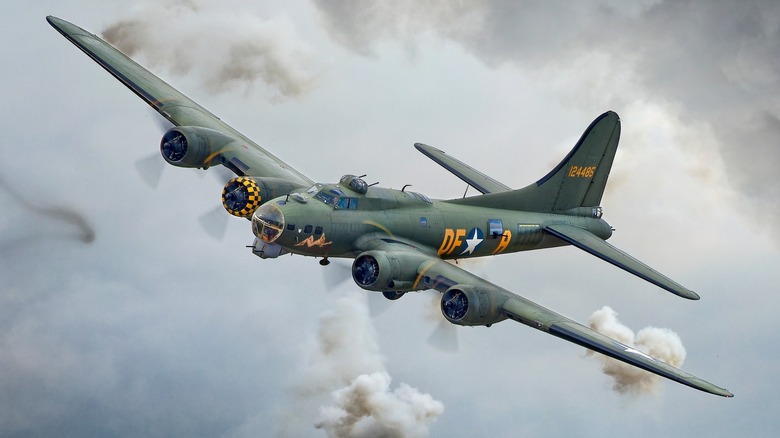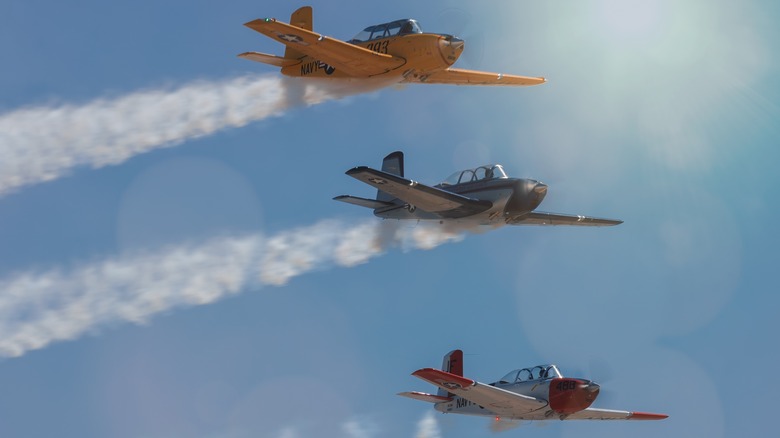What Is A Warbird And How Does It Differ From Other Aircraft?
There's an interesting term for military aircraft few outside the hobby may know about: Warbirds. This term is applied to any vintage military aircraft that's owned and operated by private individuals or organizations. This means that a Warbird could be anything from an old WWI Biplane to a fully-restored P-51 Mustang or B-17 Flying Fortress. If the military is done with it and sells it to the public, once restored, the aircraft becomes a Warbird.
Of course, the U.S. military, as well as other militaries around the world, don't typically sell old aircraft. Most often, a Warbird is something that's truly vintage, so you won't see any private pilots operating something like the F-35, seeing as it's still in widespread use around the globe. Without a doubt, the hobby of collecting, restoring, and piloting Warbirds is one only a few can manage, as owning and operating an aircraft can be expensive. Still, many around the world are happy to collect Warbirds and they're often shown off at air shows and other events.
You might think that you need some sort of connection to purchase an old fighter jet and turn it into a Warbird, but that's not the case. You can go to websites like Platinum Fighters and peruse their catalog of available aircraft. Some of the ones that appear on the site are a 1941 Nakajima A6M2 Model 21 Zero, a 1944 North American XP-82, a 1959 McDonnell F4H-1F Phantom II, and plenty more trainers, helicopters, jets, bombers, and transports.
What do people do with Warbirds?
There are numerous collectors around the globe who enjoy getting in on the Warbird hobby. Because of this, there's no specific nation that can claim Warbirds, as people in the United Kingdom, Germany, Canada, and many other nations are involved. The hobby is similar to auto restoration and collecting, so you can expect to see some beautifully restored Warbirds at places like air shows and museums in much the same way you can check out classic cars at an auto show.
While a large part of the hobby involves acquisition, restoration, and flying, there's one aspect of Warbird collecting that involves a lot of people. It's not uncommon for organizations of hobbyists to get together and put on memorial flights, simulating important battles in history. Some of the organizations that put on these performances are the Battle of Britain Memorial Flight, operated by the Royal Air Force, the Berlin Airlift Historical Foundation, Pearl Harbor Warbirds, and the Michigan Flight Museum, which displays and flies Warbirds.
Probably the biggest part of Warbird collecting is restoration, because most aircraft that are available for purchase by private parties are incredibly old. As a result, it can cost a great deal to transform an old WWII fighter into a working vehicle. Hobbyists often have to replace decals and instrument panels, repaint everything, replace worn-out parts, rewire much of the aircraft, and they have to swap out old weapon systems (though they aren't typically sold with them) for inoperative replicas — there's a lot involved in creating a Warbird.
Warbirds still have rules and regulations
Just like any aircraft, Warbirds fall under the same jurisdiction of the host nation's laws. In the States, you can run afoul of the Federal Aviation Administration (FAA) by not following the rules. More than that, you cannot arm a Warbird — they're not meant to function as they once did and are meant solely for Warbird hobbyists to work on and enjoy.
While it's okay to set up races to see which aircraft can beat a rival, loading any ordnance onto a bomber you restored is a quick and easy way to land in prison. The same is true of a former fighter's machine guns or any other equipment not authorized for personal use. This can include radar systems, radios tuned into military frequencies, and anything else your conscience tells you to think twice about. Warbirds are all about the appreciation of historical aircraft and not because you have a property dispute with a neighbor.
If you want to get involved in Warbirds in the U.S., you'll need to obtain a certification from the FAA. The FAA has a program in place and outlines all the rules and regulations any Warbird hobbyist must follow. Other countries have similar rules and regulations governing how people can own and operate Warbirds. Should you decide to enter the hobby, check out the WarBird Radio Podcast, and also, be prepared to drop a lot of money, as vintage aircraft can go from a few hundred thousand to several million dollars.


